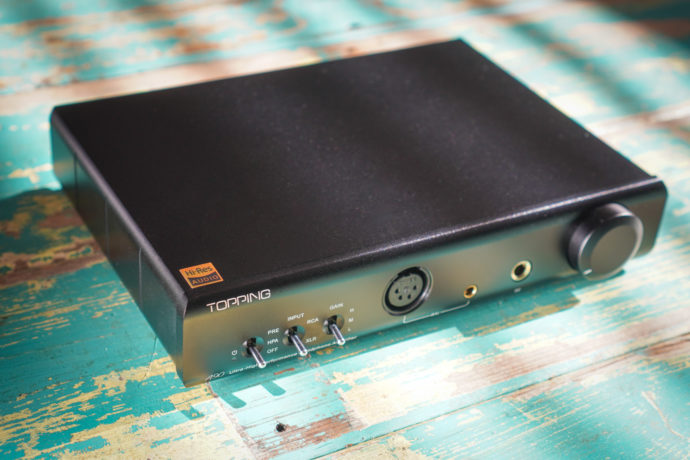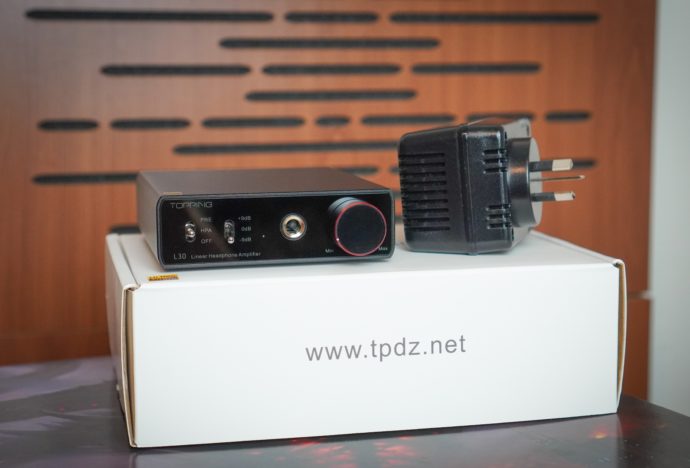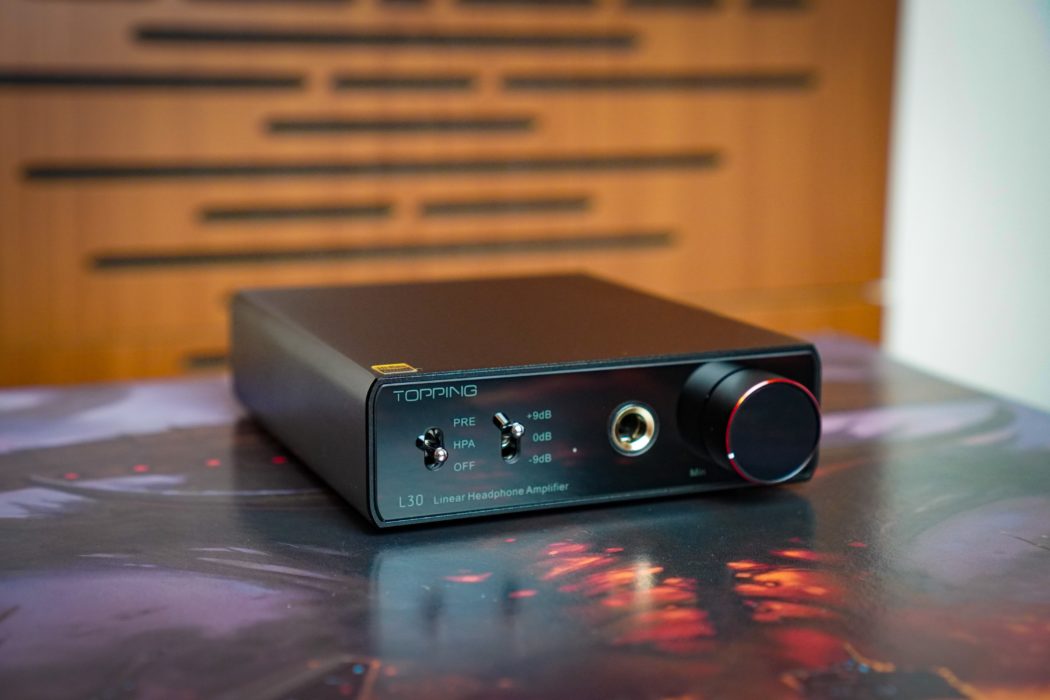In this review we look at the Topping L30 Headphone amplifier, selling for $139 USD.
The Topping L30 headphone amplifier is designed to be an analogue companion for their E30 DAC which we reviewed earlier this year.
Disclaimer: The L30 was sent to us for review from the team at HiFiGo in exchange for our honest opinion. You can check out the L30 at their online store here. As always, our thoughts are our own and we appreciate the opportunity.
Article update (January 2021): in reply to some reported incidents of device failure, Topping has implemented a recall for L30 amplifiers beginning with the serial number ‘2011’ and lower. For more, see their Facebook post and contact the manufacturer directly if you have any questions or concerns.
Topping: making waves
Personal audio manufacturer Topping has certainly been at the top of their game of-late. The prolific Chinese company has gained legions of devotees thanks to a swathe of new digital and analogue products that they have released over the past couple of years. And it’s not simply the price-tag that has lured these customers – they’ve raised the bar in the performance stakes, managing to impress the objectivist and subjectivist camps alike.
I’ve had the chance to review Topping’s $129 USD E30 DAC as well as their $499 A90 flagship headphone amplifier this year, and they are two of the easiest products that I’ve been happy to recommend to readers without question. The A90, in particular, has carved out a new performance delta and remains to be the solid-state headphone amplifier by which all others are measured. In fact, the A90 is still parked on this reviewer’s desktop thanks to its flexible balanced and single-ended inputs and outputs, great build and form-factor, and oodles of clear, precise and engaging power.

But while the Topping A90 is unquestionably an ‘end-game’ solid-state amplifier, not everyone needs to drop half a grand to make their headphones sound great. In fact, the science of headphone amplification is getting close to the point of being ‘solved’ these days. When you can nab yourself a $99 USD amp like the JDS Labs Atom or one of Schiit Audio’s $99 Magni twins and get pretty much perfect sound with 95% of all headphones on the market, you could almost call it a day and just kick-back and enjoy your music collection without worrying about what else is out there. Almost. Like all things in life, however, progress comes knocking along with evolutionary competition. Enter the Topping L30 ‘Linear Headphone Amplifier’, to introduce it by its formal name.
The L30 is Topping’s newest entry-level desktop headphone amplifier, arriving into the hotly-contest segment a tad more expensive than the competition at $139.99 USD. Form-factor wise, it’s the analogue counterpart to the E30 DAC, sharing the same basic footprint and overall dimensions – the two make for a perfect desktop ‘stack’ for a whisker under $279. The diminutive L30 is evidence of ‘trickle-down’ technology within the Topping stable, sharing the same Nested Feedback Composite Amplifier (NFCA) technology as the A90. The allows the L30 to combine an impressively high maximum power output of 3.5 Watts at 16 ohms with a dynamic range of 141dB, all the while keeping Total Harmonic Distortion and Noise (THD+N) to a paltry <0.00006%.

In order to warrant the price-drop over the A90, the L30 forgoes a few of its brother’s features – namely the inclusion of balanced architecture. The L30 sports a single full-sized 6.3mm headphone-out, a pair of RCA analogue inputs, and a pair of variable RCA outputs. That’s it. Like the A90, the power switch for the L30 sits on the front and allows the user to switch between Headphone Amplifier (HPA) and pre-out (PRE) modes. The L30 can be used in three different gain settings, allowing the listener to add -9dB, 0dB (unity), or +9dB of gain to match their headphones of choice (the gain switch also affects the pre-out levels). More precise volume attenuation can be reached via the L30’s analogue potentiometer which juts-out from the right-hand side of the L30’s polished front window. The L30 doesn’t have an on-board power supply, but rather uses a rather chunky supplied 15 VAC wall-wart. And when I say ‘chunky’ I’m not exaggerating – it weighs more than the actual amplifier!
So there you have it in terms of the L30’s capabilities on-paper. It’s a pretty minimalist kind of device not only in terms of its desktop footprint but also the way it goes about doing its job. It’s a headphone amplifier and pre-amplifier, and that’s about it. No fancy switches or party tricks. Signal goes it, and sound comes out…at the level you’d like it to. So what’s the big appeal then? The long version of the L30’s superlative specifications sheet suggests that something pretty special is going-on under the hood. Enough, in fact, to warrant audiophiles to take a closer look or better still – a listen – of the L30 with their favourite pair of headphones:
| THD+N @1kHz A-wt | <0.00007% @Output=500mW(32Ω) |
| <0.00006% @Output=80mW(300Ω) | |
| THD @20-20kHz 90kBW | <0.0001% @Output=500mW(32Ω) |
| <0.00009% @Output=80mW(300Ω) | |
| SNR@MAX OUT 1kHz A-wt | 141dB |
| Dynamic Range@1kHz A-wt | 141dB |
| Frequency Response | 20Hz-40kHz(±0.05dB) |
| Output Level | 26Vpp @G=L |
| 26Vpp @G=M | |
| 26VppG=H | |
| AP measured noise level@A-wt | <0.7uVrms @G=L |
| <0.7uVrms @G=M | |
| <0.9uVrms @G=H | |
| Actual noise level*@A-wt | <0.7uVrms @G=L |
| <0.7uVrms @G=M | |
| <0.9uVrms @G=H | |
| Channel Crosstalk@1kHz | -91dB |
| IMD CCIF@(18kHz+19kHz) | -116dB |
| IMD SMPTE@(60Hz+7kHz) | -110dB@SMPTE4: 1 |
| -115dB@SMPTE1: 1 | |
| Input Sensitivity | 25Vrms @G=L |
| 9.0Vrms @G=M | |
| 3.0Vrms @G=H | |
| Gain | -9.9dB @G=L |
| 0dB @G=M | |
| 9.5dB @G=H | |
| Output Impedance | < 0.1Ω |
| Output Power | 3500mW x 2 @16Ω THD+N<0.1% |
| 2300mW x 2 @32Ω THD+N<0.1% | |
| 280mW x 2 @300Ω THD+N<0.1% | |
| Load Impedance | >8Ω |
L30 PRE-AMP SPECIFICATIONS |
|
| THD+N@1kHz A-wt | <0.00006% |
| THD@20-20kHz 90kBW | <0.00009% |
| SNR@MAX OUT 1kHZ A-wt | 141dB |
| Dynamic Range@1kHz A-wt | 141dB |
| Frequency Response | 20Hz-40kHz(±0.05dB) |
| Output Level | 26Vpp @G=L |
| 26Vpp @G=M | |
| 26Vpp @G=H | |
| AP measured noise level@A-wt | <0.7uVrms @G=L |
| <0.7uVrms @G=M | |
| <0.9uVrms @G=H | |
| Channel Crosstalk@1kHz | -91dB |
| IMD CCIF@(18kHz+19kHz) | -116dB |
| IMD SMPTE@(60Hz+7kHz) | -110dB@SMPTE4: 1 |
| -115dB@SMPTE1: 1 | |
| Input Sensitivity | 25Vrms @G=L |
| 9.0Vrms @G=M | |
| 3.0Vrms @G=H | |
| Gain | -9.9dB @G=L |
| 0dB @G=M | |
| 9.5dB @G=H | |
| Output Impedance | 20Ω |
With numbers like this, you might be forgiven for thinking that the L30 is something of a ‘Mini A90’. And if you did, then you actually aren’t far from the truth. The L30 is very much the spiritual and sonic progeny of the A90, and so unsurprisingly, it turns out to be a very good headphone amplifier indeed. Excellent, in fact. But, with the L30 trimming itself down by forgoing a few features, size, and ultimately – power, does it still have the flexibility to be the only headphone amplifier on your desk? If so, then the L30 ought to be one stone-cold, veritable hifi bargain. Let’s take a look.
The review continues over the jump on page 2.









Sandeep
Hi, nice review. Any idea how this would fare in comparison to the ifi zen can?
Matty
The L30 is ten bucks cheaper with slightly higher single-ended output, but no balanced capability. The Zen requires strange 4.4mm adapters for use as a pre-amp, so you’d need to factor that into your overall purchase-price.
If you don’t need balanced, choose the L30.
Musikverein
So true, Matty.
This gem (and its little heavy 15V power secret) is even capable to drive my DT880/600 to more than just satisfyng level in terms of smooth quality and no-distortion-quantity.
That is why it serves as my office rig amp since late summer, happily.
Michael
Wonder how well this would drive the HiFiMan Arya…
Wills
Hi Matty, do you reckon there is any difference between this and the smsl sp200? Just by looking at the review they seem similar imo. Also, if I also add the Topping A90 into the match, do you think the A90 is a huge step up from the others? Thanks
Matty
Hey Wills, they have only a very slight difference in terms of their voicing. The SP200 sounds a little leaner than the L30, but for the most part you’re getting an entirely faithful representation of what your music and headphones sound like. I’d choose the SP200 only if you really need the extra power (perhaps for certain planars), or if you need the XLR socket for convenience. The L30 is a pretty each choice otherwise at less than half the price.
Michael
Wonder how well this would drive the HiFiMan Arya…
Matty Graham
The Arya should only need 7.65 mW to get to 100dB. The L30 will do fine with the Arya.
Loz
Hi Matty, thanks for the review. Having spent many hours recently viewing and reading reviews like this, I’m still on the fence about the benefits of a dedicated amp like this with an equivalent DAC, or a combo like the earmen sparrow, if I’m only using Spotify through my phone. I’m on the fence regarding the benefits if not using better quality source material, and also as I sometimes listen to music in bed, where a stack isn’t really a viable solution, if a sparrow or hip dac is more than good enough. I currently have Beoplay H6 gen 2, generally well reviewed, and am considering upgrading to something like the Sundara, but appreciate that needs a dedicated amp. Based on a budget of £500-550 for everything, I’d appreciate your thoughts on best bang for my buck. I listen to classical, electronic, metal, and nearly everything in between. I want something that will make me go wow. I really like Spotify for the new music I’ve found since using it and wouldn’t be in a hurry to switch, but wouldn’t rule it out completely. Thanks in advance for any help.
Matty Graham
Hi Loz, thanks for reading and taking the time to comment. Spotify is bloody great for music – it’s algorithm and discovery features are second to none. At the end of the day, enjoying music is about listening to what makes you happy, so if that’s working for you stick with it. With your budget in mind and Spotify as a source, you might enjoy using a dedicated Bluetooth headphone like the Drop x Panda, or Audeze Mobius and call it a day.
Loz
Thanks for the suggestions Matty. I looked at your review (and a few others) of the Panda and they look very interesting. Getting Drop stuff to the UK is another story. They tested a few select products, 6XX etc, for Europe, but that didn’t go anywhere. Shure Aonic 50 might be another option. Thanks again.
Andrew
Hi Matty! Thank you for an interesting review of this small but capable unit that absolutely left only one question in my mind about L30: Does it play well with entry level and popular like Fostex T50Rp Mk3 (base model)?
T50Rps are hungry and inefficient that led me to spend a few months reading forums trying to pick an amp without subjecting my wallet to inhumane destruction (resisting temptation to spend a ton on D90/A90 with some dedicated power supply before knowing ins and outs and nuances…)?
Would L30 give enough to drive them (my current “interface” is Roland Quad Capture,
and old-ish unit with 48Ohm output resistance on headphone jack, only gets them to sub-average volume and volume knob is maxed out at all times) without limiting them in any way or i should consider something along the lines of SMSL SP200 because of that THX stuff? Thanks!